MEMS oscillators offer high reliability and miniaturization with excellent temperature stability, while SAW oscillators excel in low phase noise and precise frequency control for high-frequency applications. Explore the article to understand which oscillator best suits your specific needs and performance requirements.
Comparison Table
| Feature | MEMS Oscillator | SAW Oscillator |
|---|---|---|
| Technology | Micro-Electro-Mechanical Systems (MEMS) | Surface Acoustic Wave (SAW) |
| Frequency Range | Up to 200 MHz | Up to several GHz |
| Size | Compact, chip-scale | Larger than MEMS, typically bigger die size |
| Power Consumption | Low power usage | Moderate to high power usage |
| Frequency Stability | Good stability, temperature compensated | High stability, excellent phase noise performance |
| Shock and Vibration Resistance | Excellent mechanical robustness | Moderate sensitivity to mechanical stress |
| Cost | Generally lower cost | Higher cost due to complex manufacturing |
| Common Applications | Consumer electronics, IoT, automotive | Telecommunications, radar, high-frequency systems |
Introduction to MEMS and SAW Oscillators
MEMS oscillators utilize microelectromechanical systems technology to provide highly stable frequency reference signals in compact, low-power formats ideal for modern electronic devices. SAW oscillators rely on surface acoustic wave technology, leveraging piezoelectric substrates to generate precise oscillations with excellent frequency stability and low phase noise. Both oscillator types serve critical roles in timing applications, with MEMS oscillators gaining prominence due to their robustness against vibration and shock, while SAW oscillators excel in high-frequency and RF communication systems.
Principles of Operation: MEMS vs SAW
MEMS oscillators operate using microelectromechanical systems that leverage vibrating microstructures to generate precise frequencies, while SAW oscillators utilize surface acoustic waves traveling along the surface of a piezoelectric substrate for frequency control. MEMS oscillators offer high integration potential and are less sensitive to environmental variations compared to SAW oscillators, which rely on the stability of surface wave propagation. Understanding these operational principles helps you select the optimal oscillator type for applications requiring precise timing and environmental robustness.
Frequency Stability Comparison
MEMS oscillators offer superior frequency stability over temperature variations due to their monolithic silicon structure, maintaining frequency stability typically within +-20 to +-50 ppm. SAW oscillators provide excellent short-term frequency stability with low phase noise but are more sensitive to environmental factors like temperature and humidity, causing frequency shifts that can reach +-100 ppm. Your choice depends on the specific application requirements, with MEMS oscillators favored for environments requiring robust long-term stability and SAW oscillators suited for precise, low-noise short-term frequency control.
Size and Packaging Differences
MEMS oscillators are typically smaller and more compact than SAW oscillators due to their microfabricated silicon structures, allowing for more versatile and lightweight packaging options. SAW oscillators rely on piezoelectric substrates like quartz or lithium niobate, which generally require larger, bulkier packages to protect the delicate surface acoustic waves. Choosing a MEMS oscillator can significantly reduce your device's footprint and enable more flexible integration in space-constrained applications.
Power Consumption Analysis
MEMS oscillators typically consume lower power compared to SAW oscillators, making them ideal for battery-powered and low-energy applications. MEMS technology enables significant reductions in current draw, often operating in the microampere range, which extends your device's operational life. In contrast, SAW oscillators generally require more power due to their larger signal processing needs and less efficient energy usage.
Performance in Harsh Environments
MEMS oscillators demonstrate superior resilience in harsh environments due to their robust silicon-based microelectromechanical structures, offering excellent shock and vibration resistance compared to SAW oscillators, which rely on piezoelectric substrates that can be more sensitive to mechanical stress and temperature variations. Temperature stability in MEMS oscillators typically ranges within +-20 ppm, making them more reliable for industrial and automotive applications, whereas SAW oscillators often experience larger frequency drift under extreme conditions. MEMS technology also delivers enhanced resistance to humidity and contamination, ensuring consistent performance in demanding environments where SAW devices may degrade faster.
Integration with Modern Electronics
MEMS oscillators offer superior integration with modern electronics due to their compact size, low power consumption, and compatibility with CMOS processes, enabling seamless embedding in microelectronic systems. SAW oscillators, while providing high frequency stability, often require larger substrates and additional components, making integration with compact or complex electronic devices more challenging. MEMS technology supports scalable production and easier integration for IoT devices, smartphones, and wearables where space and power efficiency are critical.
Cost and Availability Factors
MEMS oscillators generally offer lower cost and higher availability due to mass production using semiconductor fabrication processes, making them suitable for high-volume applications. SAW oscillators, while typically more expensive and less widely available, provide superior frequency stability and are often used in specialized or high-performance communication systems. Your choice depends on balancing budget constraints with the required precision and supply chain reliability.
Typical Applications of MEMS and SAW Oscillators
MEMS oscillators are widely used in consumer electronics, automotive systems, and industrial equipment due to their small size, low power consumption, and high reliability. SAW oscillators are preferred in wireless communication devices, GPS systems, and radar applications because of their excellent frequency stability and ability to operate at high frequencies. Both technologies serve critical roles in precision timing solutions across telecommunications, aerospace, and IoT networks.
Future Trends in Oscillator Technology
MEMS oscillators are rapidly advancing due to their miniaturization, low power consumption, and integration capabilities, making them ideal for IoT and 5G applications. SAW oscillators continue to excel in high-frequency stability and low phase noise, supporting RF communications and radar systems but face challenges in miniaturization. Future trends indicate a convergence where MEMS technology leverages materials and design principles from SAW to enhance performance while maintaining scalability and cost-effectiveness.
MEMS oscillator vs SAW oscillator Infographic

 solderic.com
solderic.com